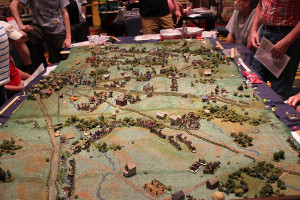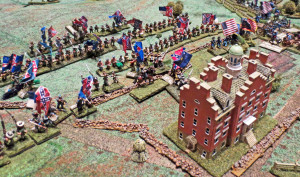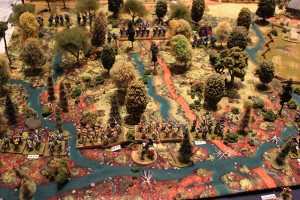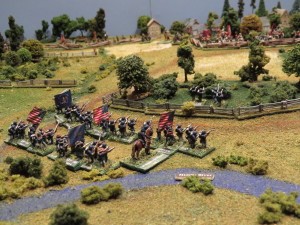Here are Dean West’s thoughts on why “Across A Deadly Field” is John Hill’s ACW masterpiece –
Dean originally published this as part of an email thread on the Johnny Reb yahoo groups page. We agreed that it might be of interest to a larger audience and he allowed us the reprint his email here.
Briefly, I think “Across A Deadly Field” (ADF) is the natural progression of the “Johnny Reb” (JR) system. Almost everyone who played in our demo games at Little Wars and Nashcon picked it up very quickly, especially JR guys, because so much of JR remains in it. But also because the mechanics are more immediately understood.
I cannot possibly describe all the subtle but significant reasons to play ADF. In short, it is just a better game. Since I am the most diehard advocate through the decades of simo-movement (order-chits) , it is no mean feat to have convinced me this game is better. I entered the first game scowling. But after one game I was convinced that ADF allows for more focus on historical maneuver of large forces and grand-tactical issues and far less “pip mining” and quibbling about rules. ADF is a smoother running game system, yet the feel is even more historical and much of the realistic feel is simulated without needing any additional rules at all. I believe this is John Hill’s ACW masterpiece.
The most significant change in ADF game mechanics is the replacement of simo-movement with a phased movement system where the sides take turns being either the Active side, or the Passive/Reactive side. During the Active player phase, each unit or contiguous group of units (brigades) get two actions. At some point the reacting player can react if certain criteria is met, such as the enemy phasing unit being visible. There are no rules controlling which Active unit/contiguous group moves first, but the unit that is selected to act must complete both it’s action phases before the next unit/group begins its action phases. This system creates all sorts of decision-making on both sides and absolutely gives the feel of simo-movement.
Brigades are more important as maneuver elements because in general movement is based on “contiguous” groupings of regiments. Most regiments are from six (360 men) to ten figs (600 men), but larger and smaller units are possible, just as in JR.
Fire mechanics are similar to JR (add and subtract D6s) but players can fire up to 16 figs in one volley. So, if one has three 6-fig units formed in a contiguous line, a total of sixteen of the eighteen figs can fire one volley (this is good) and if you are the Active player, each of your units/groups can fire twice during the active phase.
After every unit or maneuver group in the Active player’s force has completed their movement, then the other side becomes Active.
The Charge;
I never liked the charge rules on JRIII. The idea of massing a large number of supporting units behind a “point” unit to arrive at the most advantageous dice-down impact morale seemed way too gamey for my liking. ADF procedures depict a more realistic charge and support procedure. In ADF the number of units that can lower the charge’s MMP (modified morale point) is limited to two units for morale, and three unit (-3) for the impact dice-down. Supporting units must be within 1″. However, since each charging unit or group must complete both Active actions before another unit or group is activated, we now have a situation where charges are supported more realistically.
Once a charging unit/group has completed its charge, other units/groups can direct their active phases to the goal of supporting the previous charge by charging, or moving, a/o firing in a manner that exploits a breakthrough, or to sustain a repulsed unit/group. You only need to see this process in action to really appreciate how much more realistic the charge process is simulated. The “real” support is not based on pips, it is based on how subsequent movements by other unit/groups truly supports the original charge.
Though the modified impact point is aided by accumulating beneficial pips, now the real “power” lies in the number of figs in the strongest unit making the charge + the raw Impact dice roll.
Example: three units in contiguous line (units 1″ apart or less) charge. One unit has 10 figs, the other two eight. During the charge the 10 fig unit suffers one casualty and passes it’s morale.
The defensive line contains three six fig units, so center unit will subtract -2 for support, and has one unit within 1″ in rear, totalling -3 so it’s MMP is 1. Both units are veteran, which means basic BMP is 4 (but for morale rolls now the MMP dice roll only needs to EQUAL the MMP, not exceed it).
Anyway, the impact dice down is calculated as follows:
Strongest Charging unit has 9 figures because it suffered one casualty. The charging player rolls 2D6 and rolls a 7. It’s MMP is calculated at net 1 (4 for Vet, -1 for charging, and -2 for support). DRMs are determined by selecting THE 2 BEST AND THE 2 WORST DRMS (die roll modifiers, plus an officer if attached). Hence, since there are no officers involved, the charging unit’s modified Impact morale point is 1. In this case same as defender. The defender is also Vet, but it has Three supporting units (one on each flank and another within one inch in rear. So it’s point is also 1. The defending player’s impact dice roll comes up 8, but its strongest unit is six figures.
So now we do this simple calc to determine which side won the impact, and by how much. Attacker has 9 figs and rolled a 7, so add these together to arrive at 16. The defender rolled an 8, so add 8 to the strongest defending unit’s fig count, which is 6 figs + for at total of 14. Now compare the two impact DRMS, in this case a wash because each reduced BMP by 3. So the dice toll modifiers cancel each other and nothing is added due to net zero. Hence, the attacker won the impact by 2, so consult the variable outcome chart to find result.
In most cases the die roll modifiers are not equal. So let’s say for the sake of discussion that the strongest defending unit was in disorder (in ADF, disorder is now a morale grade). Disorder adds +2 to its MMP. So total MMP is 3. Attacker’s is 1. At dice down these numbers are compared and the “overage” of +2 is added to the defenders impact result, so now the defender lost by 4.
To lose by 2 means all four defenders fall back distance in inches equal to the number they lost by, 2′ in this case, and all lose a morale grade. So the impacted unit itself goes from disorder to shaken, while the supporting units become disordered. (Note: since all three defending units in this example are six figs, in the real world the defending player would not have selected a disordered unit to represent his fellow units at impact, he would have selected a 6 fig unit that was not disordered).
However, for sake of illustration, due to falling into the result category “rolls 1 to 4 less than MMP”, the additional plus 2 for disorder would not have altered the variable outcome for the defender.
This process is really much easier to do than to describe. Basically, add up figs and dice roll, then compare DRMS and assign plus minus or minus pips to appropriate unit, then add all together and HIGH number wins the impact, and check result against variable outcome table for specific outcome.
Overall, ADF provides a highly enjoyable grand-tactical game, that encourages and rewards historical play and forces the players to make constant decisions. It is the natural progression of JR and plays much faster and more intuitively. The demo games we ran at Nashcon were played with nothing more than the two-sided reference charts and all the gamers seemed to catch on quickly.
Good Gaming – Dean West
Dean was one of the original designers of “Johnny Reb” and is also part of the design team for “Across A Deadly Field”. He is currently promoting ADF on the convention circuit with his “Battle of Piedmont” scenario . He is also currently working on the “Battle of Champions Hill” scenario for ADF and on a new edition of his JR/ADF Seven Year’s War variant – “Final Argument of Kings”. He is a frequent contributor to Cigar Box Battle.






One response to “So why should you switch from “Johnny Reb” to “Across a Deadly Field”?”
Dean, do you have a copy of your American Revolutionary War rules based on Johnny Reb?